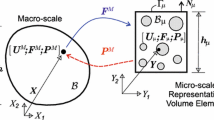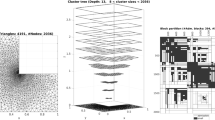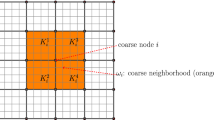Abstract
It is well known in the literature that standard hierarchical matrix (\({\mathscr{H}}\)-matrix)-based methods, although very efficient for asymptotically smooth kernels, are not optimal for oscillatory kernels. In a previous paper, we have shown that the method should nevertheless be used in the mechanical engineering community due to its still important data compression rate and its straightforward implementation compared to \({\mathscr{H}}^{2}\)-matrix, or directional, approaches. Since in practice, not all materials are purely elastic, it is important to be able to consider visco-elastic cases. In this context, we study the effect of the introduction of a complex wavenumber on the accuracy and efficiency of \({\mathscr{H}}\)-matrix-based fast methods for solving dense linear systems arising from the discretization of the elastodynamic (and Helmholtz) Green’s tensors. Interestingly, such configurations are also encountered in the context of the solution of transient purely elastic problems with the convolution quadrature method. Relying on the theory proposed in Börm et al. (IMA Journal of Numerical Analysis 12, 2020) for \({\mathscr{H}}^{2}\)-matrices for Helmholtz problems, we study the influence of the introduction of damping on the data compression rate of standard \({\mathscr{H}}\)-matrices. We propose an improvement of \({\mathscr{H}}\)-matrix-based fast methods for this kind of configuration and illustrate how the introduction of a complex wavenumber can, as expected, improve further the efficiency of such methods. This work is complementary to the recent report (Börm et al., IMA Journal of Numerical Analysis 12, 2020). Here, in addition to addressing another physical problem, we consider standard \({\mathscr{H}}\)-matrices, derive a simple criterion to introduce additional compression and we perform extensive numerical experiments.
Similar content being viewed by others
References
Banjai, L., Hackbusch, W.: Hierarchical matrix techniques for low-and high-frequency Helmholtz problems. IMA J. Numer. Anal. 28(1), 46–79 (2008)
Bebendorf, M.: Hierarchical Matrices. Springer (2008)
Bebendorf, M., Kuske, C., Venn, R.: Wideband nested cross approximation for Helmholtz problems. Numer. Math. 130(1), 1–34 (2015)
Bebendorf, M., Rjasanow, S.: Adaptive low-rank approximation of collocation matrices. Computing 70(1), 1–24 (2003)
Bonnet, M.: Boundary Integral Equations Methods in Solids and Fluids. Wiley (1999)
Börm, S.: Data-sparse approximation of non-local operators by h2-matrices. Linear Algebra Applic. 422(2-3), 380–403 (2007)
Börm, S.: Directional-matrix compression for high-frequency problems. Numer. Linear Algebra Applic. 24(6), e2112 (2017)
Börm, S., Christophersen, S.: Approximation of integral operators by Green quadrature and nested cross approximation. Numer. Math. 133(3), 409–442 (2016)
Börm, S., Grasedyck, L., Hackbusch, W.: Introduction to hierarchical matrices with applications. Eng. Anal. Bound. Elements 27(5), 405–422 (2003)
Börm, S.: Fast large-scale boundary element algorithms. arXiv:2001.05523 [cs, math] (2020)
Börm, S., Börst, C.: Hybrid matrix compression for high-frequency problems. SIAM J. Matrix Anal. Applic. 41(4), 1704–1725 (2020). Society for Industrial and Applied Mathematics
Börm, S., Lopez-Fernandez, M., Sauter, S.A.: Variable order, directional \({\mathscr{H}}^{2}\)-matrices for Helmholtz problems with complex frequency. IMA Journal of Numerical Analysis, 12. draa046 (2020)
Chaillat, S., Bonnet, M.: Recent advances on the fast multipole accelerated boundary element method for 3d time-harmonic elastodynamics. Wave Motion 50(7), 1090–1104 (2013)
Chaillat, S., Desiderio, L., Ciarlet, P.: Theory and implementation of H-matrix based iterative and direct solvers for Helmholtz and elastodynamic oscillatory kernels. J. Comput. Phys. 351, 165–186 (2017)
Ciarlet, P.G.: Introduction to Numerical Linear Algebra and Optimisation. Cambridge University Press (1989)
Darve, E.: The fast multipole method: Numerical implementation. J. Comput. Phys. 160(1), 195–240 (2000)
Golub, G.H., Van Loan, C.F.: Matrix Computations, 3rd edn. JHU Press (2012)
Grasso, E.: Modelling visco-elastic seismic wave propagation: a fast-multipole boundary element method and its coupling with finite elements. phdthesis. Université Paris-Est (2012)
Grasso, E., Chaillat, S., Bonnet, M., Semblat, J.F.: Application of the multi-level time-harmonic fast multipole BEM to 3-D visco-elastodynamics. Eng. Anal. Bound. Elements 36(5), 744–758 (2012)
Greengard, L., Huang, J., Rokhlin, V., Wandzura, S.: Accelerating fast multipole methods for the Helmholtz equation at low frequencies. IEEE Comput. Sci. Eng. 5(3), 32–38 (1998)
Greengard, L., Rokhlin, V.: A fast algorithm for particle simulations. J. Comput. Phys. 73(2), 325–348 (1987)
Hackbusch, W.: A sparse matrix arithmetic based on \({\mathscr{H}}\)-matrices. Part I: Introduction to \({\mathscr{H}}\)-matrices. Computing 62(2), 89–108 (1999)
Hackbusch, W: Hierarchical Matrices: Algorithms and Analysis, vol. 49. Springer (2015)
Hackbusch, W., Nowak, Z.P.: On the fast matrix multiplication in the boundary element method by panel clustering. Numer. Math. 54(4), 463–491 (1989)
Liu, Y.J., Mukherjee, S., Nishimura, N., Schanz, M., Ye, W., Sutradhar, A., Pan, E., Dumont, N.A., Frangi, A., Saez, A.: Recent advances and emerging applications of the boundary element method. Appl. Mech. Rev., 64(3) (2011)
Lopez-Fernandez, M., Sauter, S.: Generalized convolution quadrature with variable time stepping. IMA J. Numer. Anal. 33(4), 1156–1175 (2013). Conference Name: IMA Journal of Numerical Analysis
Lubich, C.: Convolution quadrature and discretized operational calculus. I. Numer. Math. 52(2), 129–145 (1988)
Lubich, C.: Convolution quadrature and discretized operational calculus. I II. Numer. Math. 52(4), 413–425 (1988)
Mavaleix-Marchessoux, D., Bonnet, M., Chaillat, S., Leblé, B.: A fast BEM procedure using the Z-transform and high-frequency approximations for large-scale 3D transient wave problems. International Journal for Numerical Methods in Engineering. Wiley (2020)
Messner, M., Schanz, M., Darve, E.: Fast directional multilevel summation for oscillatory kernels based on Chebyshev interpolation. J. Comput. Phys. 231(4), 1175–1196 (2012)
Rokhlin, V.: Rapid solution of integral equations of classical potential theory. J. Comput. Phys. 60(2), 187–207 (1985)
Sauter, S.: Variable order panel clustering. Computing 64(3), 223–261 (2000)
Sauter, S.A., Schwab, C.: Boundary element methods. In: Boundary Element Methods, pp. 183–287. Springer (2010)
Schanz, M.: Application of 3D time domain boundary element formulation to wave propagation in poroelastic solids. Eng. Anal. Bound. Elem 25(4), 363–376 (2001)
Schanz, M., Antes, H.: A new visco- and elastodynamic time domain boundary element formulation. Comput. Mech. 20(5), 452–459 (1997)
Semblat, J.-F., Luong, M.P.: Wave propagation through soils in centrifuge testing. J. Earthquake Eng. 02(01), 147–171 (1998). Imperial College Press
Wilkes, D.R., Duncan, A.J.: A low frequency elastodynamic fast multipole boundary element method in three dimensions. Comput. Mech. 56(5), 829–848 (2015)
Author information
Authors and Affiliations
Corresponding author
Ethics declarations
Conflict of interest
The authors declare no competing interests.
Additional information
Communicated by: Michael O’Neil
Publisher’s note
Springer Nature remains neutral with regard to jurisdictional claims in published maps and institutional affiliations.
This article belongs to the Topical Collection: Advances in Computational Integral Equations
Guest Editors: Stephanie Chaillat, Adrianna Gillman, Per-Gunnar Martinsson, Michael O’Neil, Mary-Catherine Kropinski, Timo Betcke, Alex Barnett
Rights and permissions
About this article
Cite this article
Bagur, L., Chaillat, S. & Ciarlet, P. Improvement of hierarchical matrices for 3D elastodynamic problems with a complex wavenumber. Adv Comput Math 48, 9 (2022). https://doi.org/10.1007/s10444-021-09921-3
Received:
Accepted:
Published:
DOI: https://doi.org/10.1007/s10444-021-09921-3




